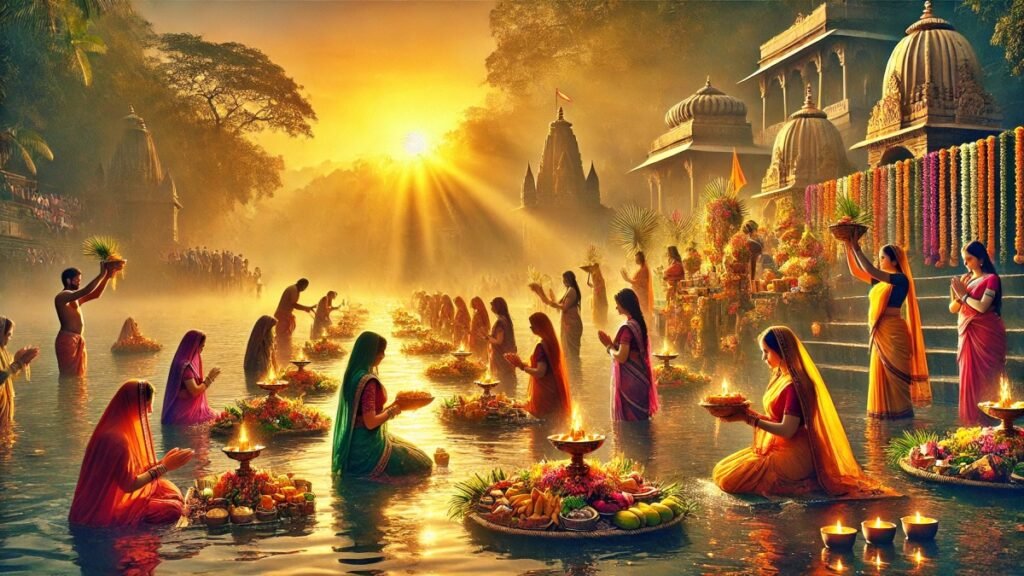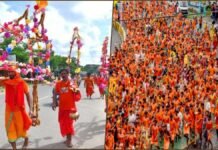
Chhath Puja, one of the most challenging and revered fasts observed after Diwali, is celebrated with deep devotion by married women praying for their family’s happiness, peace, and the long lives of their children. Known as a Mahaparva (great festival), this four-day ritual culminates on the Shashthi Tithi (sixth day) of the Shukla Paksha in the Kartik month, dedicated to the worship of Surya Dev (Sun God) and Chhathi Maiya. With a rigorous 36-hour fast, devotees follow specific rituals and rules to honor the deities. But do you know the origins of this powerful observance? Ancient legends tell us that Chhath Puja dates back to the time of Ramayana and Mahabharata, celebrated first by Mata Sita and later by Draupadi and Karna.
Mata Sita’s Divine Devotion: The First Chhath Puja
According to the Ramayana, the origins of Chhath Puja trace back to when Mata Sita, alongside Lord Rama and Lakshman, returned to Ayodhya after 14 years in exile. To atone for the killing of Ravana, Lord Rama was advised by sages to perform a Rajyagya dedicated to Surya, the Sun God. The wise sage Mugdal Rishi conducted the rituals, cleansing Mata Sita with Gangajal (holy water from the Ganges) and instructing her to observe a fast in honor of Surya Dev on the sixth day of Shukla Paksha in Kartik.
For six days, Mata Sita worshipped the Sun God with devotion while staying at Mugdal Rishi’s ashram. On the seventh day, at sunrise, she offered Arghya (a ritual offering) to Surya, receiving divine blessings for her dedication. This marked the beginning of Chhath Puja, a tradition that continues to bring blessings and prosperity to devotees.
Draupadi and Karna: Legends of Chhath During Mahabharata
Another legendary origin of Chhath Puja lies in the Mahabharata era, where it is believed that Karna, the son of Surya, was among the first to worship the Sun God. Known for his unwavering devotion, Karna would stand in water for hours, offering Arghya to Surya Dev, gaining immense strength and warrior skills through the Sun God’s blessings. This ancient ritual of offering Arghya at dawn and dusk has become a cornerstone of Chhath Puja, connecting devotees with Surya’s divine energy.
The Mahabharata also narrates how Draupadi, the wife of the Pandavas, turned to Chhath Puja during times of crisis. After the Pandavas lost their kingdom in a gambling match, Draupadi observed the rigorous Chhath fast with unwavering faith, praying for the restoration of their fortunes. Her devotion moved the gods, and soon after, the Pandavas regained their kingdom.
Rituals and Legacy of Chhath Puja
Over centuries, Chhath Puja has become a widely cherished festival, particularly in Bihar, Jharkhand, Uttar Pradesh, and Nepal, symbolizing purity, discipline, and deep devotion to Surya Dev. During these four days, devotees observe a disciplined regimen, which includes taking dips in holy rivers, offering evening Arghya to the setting sun, and concluding the fast with a morning Arghya at sunrise. Each ritual is filled with symbolic meaning, connecting devotees to the cosmic power of the Sun and the blessings of Chhathi Maiya, who grants health, prosperity, and longevity.

The festival is a profound reminder of faith, rooted in ancient epics and the blessings of celestial forces. Through the observance of Chhath Puja, devotees not only honor age-old traditions but also seek divine blessings for their families, guided by the legends of Mata Sita, Draupadi, and Karna.



















































